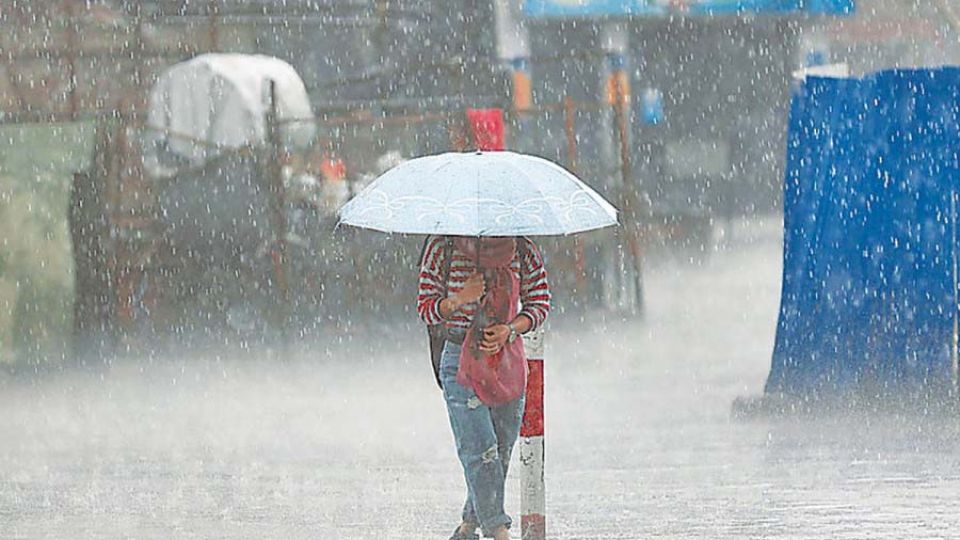May 7, 2024
Cumulonimbus clouds are associated with extreme weather conditions such as heavy torrential rain, hail storms and lightning.
“Cumulonimbus clouds generally form and dissipate within an hour after heavy rainfall,” said Saroj Pudasaini, a meteorologist at the division. “This type of rainfall will happen on Monday and Tuesday as well.”
But the real respite from scorching heat, haze and air pollution could come Tuesday, with light to moderate rainfall predicted on the day throughout the country.
According to the Met officials, the moisture-laden wind blowing from the Bay of Bengal is expected to enter the country and cause rainfall in some places of the hilly areas of Koshi, Bagmati and Gandaki on Monday and throughout the country on Tuesday. Some hilly areas of the said provinces could also see light rainfall with thunder on Sunday night, met officials said.
“Chances of rainfall on Monday are 10 to 20 percent, but on Tuesday, most places across the country would witness light to moderate rain,” said Rojan Lamichhane, a meteorologist at the division. “Cyclonic circulation, also known as circulating winds, could cause rainfall in particular areas from Tuesday too.”
Experts say cyclonic rains occur when the warm moist air comes in contact with cool dry air. At the end of summer, the air above the water heats up and rises, creating a low-pressure area.
The last time the country witnessed good rainfall was in the third week of March. Due to the lack of rain for a prolonged period, the country has been experiencing drought-like conditions. People across the Tarai region have been affected by scorching heat.
Severe water scarcity has been reported in many places throughout the country.
Health facilities of the Tarai region have been still grappling with an uptick in cases of diarrhoea, vomiting, and urinary infections, among other ailments.
Forests throughout the country have been either gutted by fires or are burning, deteriorating the air quality. Even flights in many places including Pokhara and Lukla, two of the country’s most popular tourist destinations, have been affected by the smoke and haze. Kathmandu has of late been among the most polluted cities in the world.
The met office had issued a special bulletin of heat wave warning twice in the third and fourth week of April.
Experts say a heat wave occurs when the maximum and minimum temperatures at a location are unusually high over two consecutive days.
Exposure to excessive heat causes tiredness, weakness, thirst, headache, leg cramps, muscle pain, vomiting, dizziness and fainting, according to the department.
Heat-related illnesses include heat stroke, heat exhaustion, heat cramps and heat syncope (fainting). Heat stroke is the most severe form of heat-related illness and requires immediate medical attention.
Officials said people should take precautions if the maximum temperature in their place exceeds 40 degrees Celsius. They advise people not to venture out of their homes in the afternoon, to take sufficient fluids and water to remain hydrated and to wear cotton clothes to avoid the adverse effects of the scorching heat.
Meanwhile, the maximum temperature of most districts across Tarai region went down on Sunday, except in Banke and Kailali.
According to the Meteorological Forecasting Division, the maximum temperature of Bhairahawa has been recorded 38.7 degree Celsius, Janakpur 43.7, Biratnagar 33.6, Simara 36.3, Nepalgunj 41.2 and Dhangadhi 41.5 degrees Celsius. Kathmandu recorded a maximum of 30.3 degrees Celsius.
The national capital recorded 36.6 degrees Celsius on May 7, 1989, the most extreme temperature ever recorded in the city.
The World Health Organisation said that heatwaves are among the most dangerous natural hazards, but they rarely receive adequate attention because their toll and destruction are not always immediately obvious.
People’s exposure to heat is increasing due to climate change. Globally, extreme temperature events are increasing in frequency, duration and magnitude, according to the UN health body.
A new report from the World Meteorological Organisation said that the impact of heat waves became more severe in Asia in 2023.
“Asia is warming faster than the global average. The warming trend has nearly doubled since the 1961–1990 period,” the report states. “Many countries in the region experienced their hottest year on record in 2023, along with a barrage of extreme conditions from droughts and waves to floods and storms.”
According to the report, Asia remained the world’s most disaster-hit region to weather, climate and water-related hazards in 2023. Floods and storms caused the highest number of reported casualties and economic losses, according to the report of the organisation, a specialised agency of the United Nations whose mandate covers weather, climate and water resources.
“Climate change exacerbated the frequency and severity of such events, profoundly impacting societies, economies and most importantly, human lives and the environment that we live in,” the report quoted WHO Secretary-General Celeste Saulo as saying.
Nepal is one of the most vulnerable countries in the world to the climate crisis and has witnessed extreme weather events over the past decade and a half.
The average annual maximum temperature of Nepal has risen by 0.056 degrees Celsius, according to a study conducted by the Department of Hydrology and Meteorology in 2017. The study shows most districts witnessed increasing temperatures annually.


